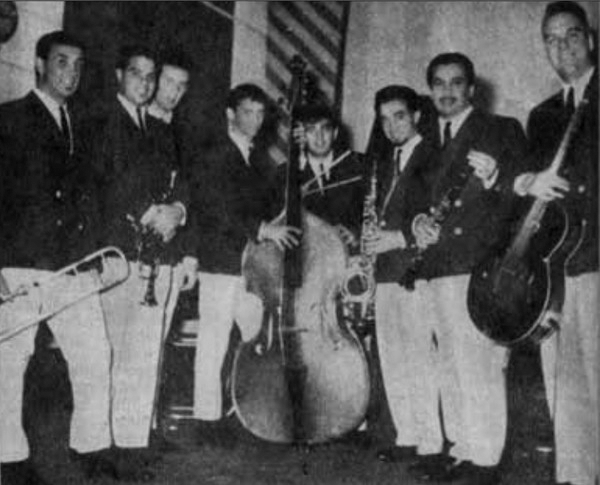El Trio Fattoruso
Montevideo, Uruguay: It’s been six decades since Antonio Fattoruso formed El Trio Fattoruso.
Playing an inverted bucket bass (using a broom as the neck, and a cord as the instrument’s single string), Antonio drafted his two young sons, Hugo on piano & accordion, and “Osvaldo” on drums. The trio performed at street festivals, covering the variety of styles used in Uruguay’s carnivals (boleros, murgas, tangos, etc.).
The Hot Blowers
Hot Blowers (left to right) Cacho De La Cruz trombone Daniel “Bachicha” Lencina leader, trumpet Hugo “Ringo” Thielmann piano Hugo Fattoruso contrabass “Bebe” Alfonso drums “Chocho” Paolini tenor saxophone “Tito” Caballero clarinet Edunio Gelpi guitar
At the age of 16 Hugo moved to the upright bass and began his tenure as the under-aged member of The Hot Blowers, a swing band that toured throughout Latin America in the late 1950s. This period could be seen as a second important milestone in Hugo's harmonic education, hammering home the concepts of improvisation and musical interplay.
Los Shakers
Los Shakers (left to right) Hugo Fattoruso guitar, voice Roberto "Pelin" Capobianco bass, voice Osvaldo Fattoruso guitar, voice Carlos "Caio" Vila drums, voice
By the early 1960s, rock ’n’ roll began to shake the world’s foundation, Hugo & Osvaldo set out to express themselves in that medium by forming ‘Los Shakers’. Almost overnight Los Shakers were a huge success throughout Latin America, as they molded the complexities of bossa’s harmonies, Uruguay’s urban song style, candombe rhythms and the backbeat of rock into a new contagious form.
OPA
Photograph © Mario Marotta: OPA (left to right) Jorge Osvaldo Fattoruso drums, voice Hugo Fattoruso keyboards, voice Ringo Thielmann electric bass, voice
By the late 1960s the influence of jazz took the Fattoruso brothers to New York City, where they formed the group ‘Opa’. Opa’s mixture of jazz, rock, Brazilian harmonies and rhythms, and Uruguay’s unique Candombe rhythm gave this band a distinctive voice, and garnered them recognition among musicians in the then growing “Latin Jazz” scene. Opa’s music served to influence the next generation of Uruguayan musicians, continuing the Fattorusos’ impact on Uruguayan music culture.
From that point on Hugo has worked with a variety of artists, ranging from Ron Carter to The Dixie Dregs. He has worked with several prominent Brazilian artists including Chico Buarque de Holanda, Hermeto Pascoal, Djavan, María de Fátima, Nana Vasconcelos, Geraldo Azevedo, João Bosco and Toninho Horta. He has recorded extensively with Milton Nascimento, on the records 'Milton', 'Journey To Dawn', 'Planeta Blue Na Estrada Do Sol', 'Angelus', and ‘Nascimento’ (awarded the 1998 World Music Grammy). In addition to Hugo’s contribution on piano and accordion, various tracks on the release 'Nascimento' were co-arranged by Milton and Hugo.
Upon his return to Uruguay, Hugo embarked on an active solo career, projects including Los Pusilanimes, Rey Tambor, Grupo del Cuareim, Quinteto Barrio Sur, Dos Orientales with Tomohiro Yahiro, and HA Duo with Albana Barrocas. In addition, many collaborators including Eduardo Mateo, Jaime Roos, Fernando “Lobo” Núñez, Leo Masliah, Urbano Moraes, Pitufo Lombardo, Jorge Galemire, Argentina's Fito Páez, Luis Salinas, and many others.
The millennium began with Fattoruso Trio breaking new ground. Osvaldo on drums, Hugo drafts his son Francisco on electric bass, an evolving family affair.
La Nación, Argentina “a volcano of creativity”
All About Jazz, Todd S. Jenkins “a torrential downpour of fresh sounds”





